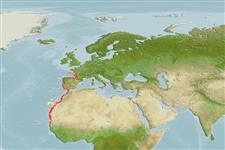Classification / Names
Common names from other countries
Main reference
Size / Weight / Age
Max length : 60.0 cm SL male/unsexed; (Ref. 5304); common length : 45.0 cm TL male/unsexed; (Ref. 26999)
Environment
Marine; demersal; depth range 12 - 65 m (Ref. 5304)
Climate / Range
Tropical, preferred 22°C (Ref. 107945); 47°N - 14°N, 19°W - 1°W
Distribution
Short description
Dorsal
spines
(total): 0;
Dorsal
soft rays
(total): 72-95;
Anal
spines: 0;
Anal
soft rays: 60 - 75;
Vertebrae: 44 - 46. Last ray of dorsal and anal fins joined by a low membrane to the base of the caudal fin. Supratemporal branch of lateral line forming an arch. Anterior nostril on the blind side not enlarged, its diameter about half that of the eye; it is situated rather close to the front margin of head, the distance slightly greater than that separating the nostril from the mouth cleft, 1:1-1.4. Length of scales above nasal tube on ocular side much less than the length of the tube. Gill rakers like short knobs on first gill arch on ocular side. Pectoral fin on the ocular side with a black botch over the whole middle and distal part of the fin; blind side whitish (Ref. 32649).
IUCN Red List Status (Ref. 115185)
Threat to humans
Harmless
Human uses
Fisheries: commercial; aquaculture: experimental
Tools
Special reports
Download XML
Internet sources
Estimates of some properties based on models
Phylogenetic diversity index
PD50 = 0.5020 many relatives (e.g. carps) 0.5 - 2.0 few relatives (e.g. lungfishes)
Trophic Level
3.3 ±0.46 se; Based on food items.
Resilience
Medium, minimum population doubling time 1.4 - 4.4 years (Preliminary K or Fecundity.)
Vulnerability
Moderate to high vulnerability (49 of 100)
Price category
